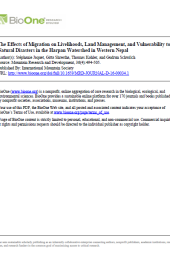The Effects of Migration on Livelihoods, Land Management, and Vulnerability to Natural Disasters in the Harpan Watershed in Western Nepal
Summary
This study examines the multifaceted impact of migration on livelihoods and land in Nepal, with a focus on the shift in resource pressures from outmigration to in-migration areas and the potential trade-offs between economic benefits and increased land degradation. Migration, driven by factors such as conflict, poverty, and job opportunities, is a prevalent trend in mountain regions. Remittances from migrants significantly contribute to income in developing nations, reshaping household consumption patterns. In Nepal, the surge in foreign employment migration has led to remittances constituting 29% of the national GDP. While some studies explore the effects of migration on livelihoods and poverty dynamics, limited research has delved into its impact on land resources and management. The study employs the sustainable livelihoods approach to understand the complex interplay between social and ecological systems, emphasizing the need to adapt the framework to contemporary research developments. The research hypotheses examine the shifting pressures on resources and potential environmental consequences associated with migration. The study aims to elucidate the intricate relationship between migration, livelihoods, and land management in both uphill and downhill areas of the watershed, highlighting opportunities and risks while acknowledging the need for further exploration of ethnicity's role in livelihood choices.
Categories:
Article
Publisher:
International Mountain Society
Published Year:
2016
